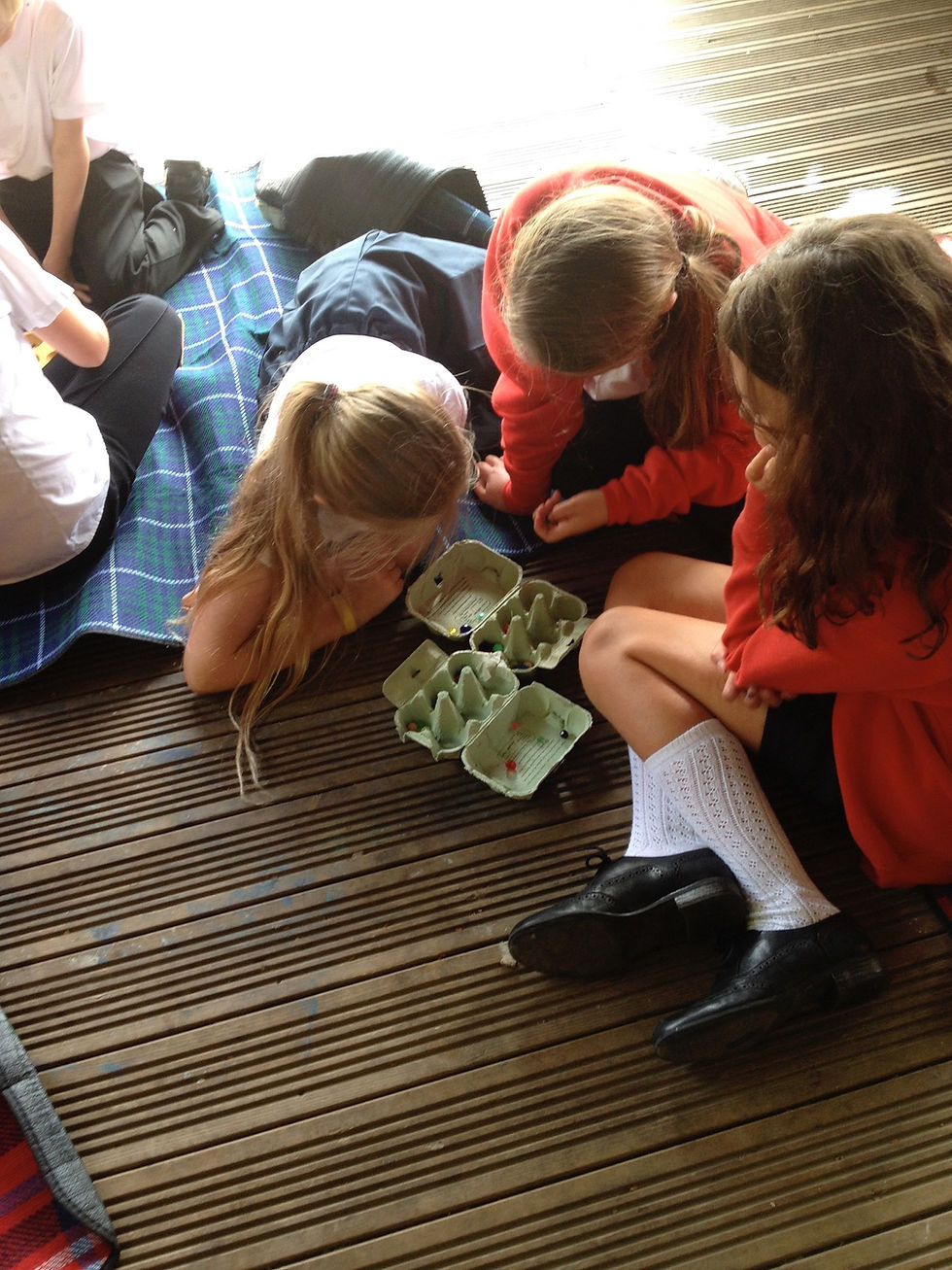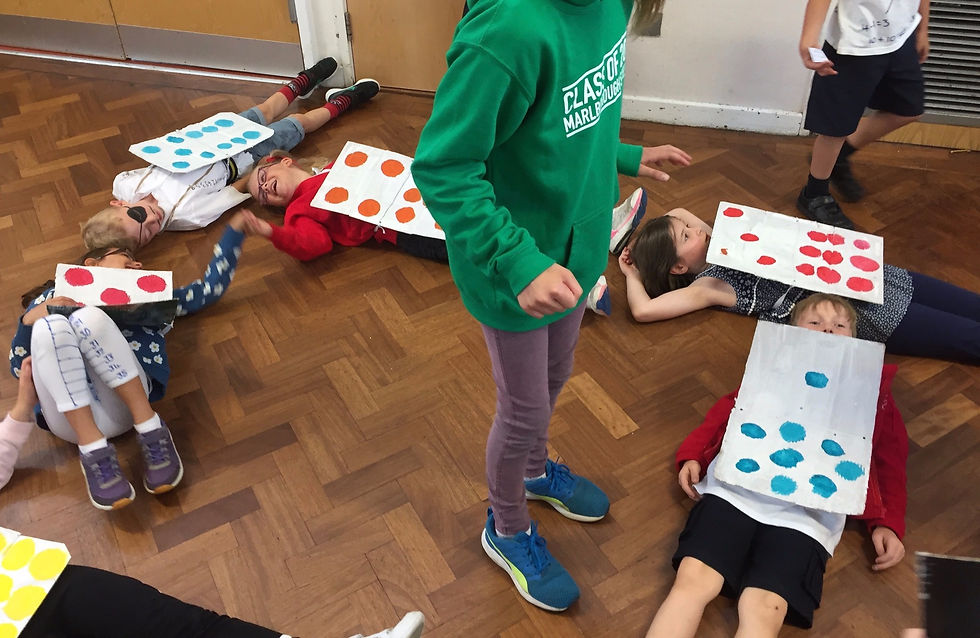Scripting lessons – surely not?
- Dr Helen J Williams
- Mar 4, 2020
- 4 min read
Updated: Mar 5, 2020

(Playing Mancala with homemade playing bases )
The issue of 'scripted lessons' crops up from time-to-time. I originally posted this blog of my thoughts around this in September 2018, after reading a TES article by @EnserMark, published on 31 August 2018 (https://www.tes.com/magazine/article/gripped-script ). Shortly before this @dylanwiliam had suggested on Twitter that I was dismissing scripted lessons without due consideration. Here are my considerations.
In his TES piece Mark talks of his lessons being different in that they are scripted. He quotes @bennewmark saying that the preparation of explanations was now taking up most of his planning time.
I have always understood ‘scripted lessons’ to mean reading from an ‘approved’ script. This is not teaching. Mark’s TES article made me revisit what ‘scripted lessons’ might be.
I realise I am writing with my primary and early years hat on and that both Mark and Ben (and Dylan) are secondary teachers. But I am interested in exploring Mark’s interpretation of ‘scripting’ lessons and how that might (or might not) apply to the mathematics sessions I teach in early years and primary classrooms.
Here is my conjecture; that effective early years and primary teachers, in the sense Mark writes, do script their lessons. What follows are my reflections on the process I go through when planning a mathematics session.
Firstly, after deciding the focus, I have to think through the sequence and possible trajectories of a fragment of learning; the “foreseen possibilities” to quote Marion Bird https://www.amazon.co.uk/Mathematics-Young-Children-Thinking-Approach/dp/0415059518/ref=sr_1_1?s=books&ie=UTF8&qid=1538751938&sr=1-1&refinements=p_27%3AMarion+Bird
I have to think about how this links to other learning, and prepare how to make this accessible for all participants (“What will Esme do?” What resources / images do I require?” “How will I actually start?” “What will I say first?” “Then what?” "What if..?")
Mark focuses his article on scripting explanations, and I see this as analogous to my thinking through the start of a session. What I say and do here, in those first moments, I have found to be critical; after that, I need to think carefully about (plan) likely interactions with the children. The questions I am going to ask and when, the times to wait, the times to listen intently, the times to sum up…
I make sure I plan the moments I am not going to speak, by highlighting in my notebook the thing I say before I stay quiet. These are key moments for me; key in shifting who does the mathematics from myself to the pupils.
I think through how I might respond to an off-the-wall child response: “Can you say a little more about that?” “Who can see what Sam is saying and can say it in their own words?”
In particular, I think about how I respond to ‘correct’ answers, because I know a lazy response to a ‘correct’ answer - “Yes, well done Rafael” - can shut down everyone else’s.
I have worked with teachers where we have developed sessions by just planning the things we are going to say. These have been illuminating and have made us better prepared in other teaching sessions.

(Human dominoes)
Mark talks of the anxiety he felt of starting an explanation that he didn’t know how to finish. I recognise this; for me it was the anxiety of dealing with what I considered an off-the-wall response. A critical moment for me (Noddings is interesting on these) http://infed.org/mobi/nel-noddings-the-ethics-of-care-and-education/ took place in a Y1 class, with a bucket of of interlocking cubes in three colours. I asked the children to “See how many different pairs you can make”, and turned to work with another small group. When I turned back there were indeed constructions, but none I recognised as pairs. At a loss, I asked what they had been working on: “Well, I made pears and he made bananas and over there is an orange”.
I now recognise such responses are only off my wall, and time beforehand thinking what might be heard and what I might hear; rehearsing the session, if you like; prepared me better for moments I don’t see how what is said connects with what I am thinking. In responding to the unexpected I tend to use something like the following: “Ah! I think you are seeing ... here, is that right or wrong, Aarav?” “Let me just write what you said up here, Alice, for now, so we don’t forget to think about this later”,

(Time for reflection)
A lot of this ‘planning’ is done in the car, or walking the dog, or ironing, or in front of the TV (but not exactly watching it). I don’t know about anyone else, but I have always found it impossible to do this sort of thinking in school-based PPA time; in-school PPA is the time I used for sorting, organising, outline planning with colleagues, researching.
The sort of planning I refer to here requires head-space and quiet. When I have that, I can write it down quite quickly (5-minute lesson plan style https://www.teachertoolkit.co.uk/5minplan/ ).
And this sort of scripting is what the craft of teaching is all about.
References:
Bird, M. H., (1991) Mathematics for Young Children: An active thinking approach. London; New York: Routledge
Noddings, N., (2006) Critical Lessons: What our schools should teach. New York: Cambridge University Press





Comments